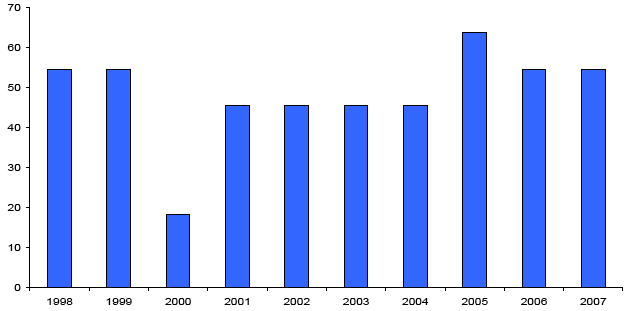Key Scottish Environment Statistics 2009
Annual publication containing summary of key statistics on environmental trends in Scotland
Marine
Percentage of commercial continental shelf finfish stocks at full reproductive capacity: 1998-2007 3
Percentage of fish stocks at full reproductive capacity

1998 |
2000 |
2004 |
2005 |
2006 |
2007 3 |
|
|---|---|---|---|---|---|---|
Number out of 11 finfish stocks at full reproductive capacity |
6 |
2 |
5 |
7 |
6 |
6 |
Percentage at full reproductive capacity |
55 |
18 |
46 |
64 |
55 |
55 |
Fish stocks require a healthy marine environment and sustainable harvest levels. If stocks are in a poor state or overfished it can have a knock-on effect on other parts of the marine ecosystem. The state of commercial fish stocks may be considered, alongside other indicators, as a proxy for the general sustainability of the marine environment.
The state of fish stocks can be assessed, in part, by estimating the biomass of the spawning population of each stock. 4 For each fish stock the biomass estimate is compared against a reference level; if above that level the stock is considered to be at full reproductive capacity and there is a good probability that harvest rates are sustainable. If a fish stock is below full reproductive capacity it indicates that spawning levels may be insufficient to guarantee stock replenishment and stock abundance will probably decrease. The data shown here relate to 11 commercial continental shelf finfish stocks 5 located in waters surrounding Scotland.
The number of finfish stocks monitored that were at full reproductive capacity fell from 6 in 1998 to a low of 2 in 2000. This then rose to a peak of 7 in 2005, before returning to 1998 levels in 2006 and 2007. The fish stocks not at full reproductive capacity in 2007 were North Sea Cod and West of Scotland Cod, whilst North Sea Herring, North Sea Norway Pout and West of Scotland Haddock were reported to be at risk of being below full reproductive capacity.
Source: Marine Scotland Science, ICES6
There is a problem
Thanks for your feedback